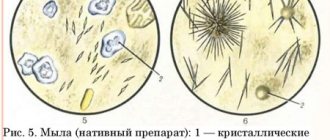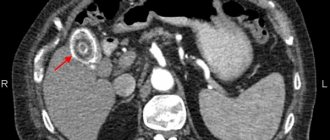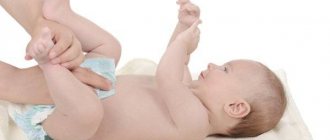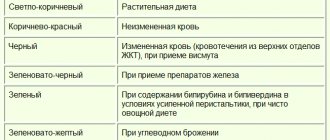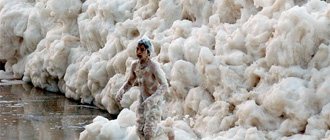What does it mean - mushrooms in stool
In the body of a healthy person, beneficial and relatively dangerous microorganisms constantly function. The balance of these components ensures the normal functioning of the digestive system, good health, and well-being. When exposed to unfavorable factors, the balance of bacteria is disrupted, and pathogenic organisms, especially fungi of the genus Candida, begin to colonize the intestinal microflora.
Fungi multiply every minute. Their vital activity leads to the accumulation of toxins on the intestinal walls and in the blood. The immune system is weakened, the functioning of the esophagus is disrupted, the person experiences difficulty with bowel movements, feels unwell, and is constantly weak.
Against the background of the growth of pathogenic microorganisms, inflammatory processes begin. Painful sensations appear. Over time, fungi penetrate into neighboring organs, disrupting their functioning. Very often the reproductive system and urinary system suffer.
Causes of fungal growth in stool
External and internal factors can disrupt intestinal function.
Causes of dysbiosis in adults:
- stress, nervous system tension, overwork;
- pathologically weak immunity or weakened by other diseases;
- alcohol;
- abuse of strong coffee;
- consumption of large quantities of sweets and flour products;
- smoked, salty, fatty foods;
- disrupted diet - snacks, heavy dinners;
- inflammatory processes in the body;
- treatment with antibiotics and other medications;
- sexually transmitted diseases, vaginal dysbiosis;
- stomach diseases;
- intestinal pathologies;
- unfavorable environment;
- disrupted menstrual cycle in women;
- pregnancy;
- hormonal imbalance, taking hormonal drugs, including anti-inflammatory drugs;
- oncology;
- vitamin deficiency or hypervitaminosis;
- disruption of the circulatory system, problems with blood pressure;
- contact with chemicals, their entry into the stomach.
The main cause of intestinal dysbiosis can be considered reduced immunity, which is not able to restrain the growth of pathogenic microorganisms.
Causes of mushrooms in a child’s stool:
- dirty hands;
- licking toys;
- eating unwashed berries, vegetables, fruits;
- pathological processes in the immune system;
- abuse of sweets, chips, crackers;
- disrupted diet;
- beer, carbonated drinks, alcohol;
- stress;
- hormonal changes in adolescents;
- diseases of the digestive system;
- medication use;
- lack of vitamins;
- unfavorable psychological environment in the home or educational institution.
This is interesting: Gonorrhea, what kind of disease, its signs and treatment
Children's dysbiosis occurs due to an unstable immune system, the intestines are not fully formed. In infancy, this manifests itself in the form of colic, constipation, and later other painful manifestations appear.
Predictions and prevention
The prognosis for non-invasive intestinal candidiasis caused by antibiotics or intestinal infections is favorable. During therapy, symptoms are completely eliminated within 3-5 days, complete suppression of the fungus occurs within 7-10 days. In the presence of predisposing diseases, the further development of candidiasis depends on the course of the underlying pathology.
Thus, the destruction of candida without antiviral treatment against the background of HIV leads to relapse in a fairly short time. Cancer patients receiving chemotherapy and radiation treatment are virtually unresponsive to antifungal drugs. In diabetes mellitus, candidiasis can be completely eliminated only after blood sugar levels have stabilized.
Primary prevention of intestinal candidiasis consists of avoiding self-administration of antibacterial agents, observing personal hygiene requirements, and maintaining an optimal ratio of proteins, carbohydrates and fats in the diet. It is recommended to eliminate all existing foci of chronic infection (deep caries, chronic runny nose, recurrent forms of tonsillitis).
Yeast in the stool of adults and children is a symptom of the disease. Its type and severity are determined during laboratory and clinical examination of the patient. It is impossible to ignore the test result, which contains the candida fungus. You should definitely consult a doctor to receive qualified advice, assess the severity of the condition, and prescribe the necessary therapy.
It is periodically necessary to be tested for dysbacteriosis and the presence of yeast in the stool. It is necessary to monitor their level and, if the norm is exceeded, contact a pediatrician.
Children at risk of the disease should limit their intake of sugar, as it stimulates the growth of fungus. The diet should be enriched with fiber, natural products, and vitamin complexes. It is important to perform a full medical examination at least once a year, which includes collecting all tests for laboratory tests.
Symptoms of fungi in the intestines
Dysbacteriosis has the ability to masquerade as other diseases, has vague symptoms, and manifests itself differently in everyone. Main symptoms:
- causeless weakness, fatigue, decreased ability to work;
- nausea, in rare cases vomiting;
- rumbling, bloating;
- constipation or diarrhea;
- feces with an unpleasant pungent odor;
- pain around the navel, in the lower abdomen;
- persistent headache as a sign of toxicosis;
- slight increase in temperature;
- loss of appetite;
- weight loss;
- pale skin color;
- unpleasant taste in the mouth;
- yellow or white coating on the tongue;
- brittleness of hair and nails;
- allergic reactions on the skin;
- acne;
- irritability, bad mood;
- insomnia, daytime sleepiness;
- frequent colds;
- thrush of the genital organs.
This symptomatology is typical for an adult and a child, but childhood dysbiosis has its own characteristics.
Causes and pathogenesis
Yeast fungus Candida
There are 2 mechanisms for the development of candidiasis dysbiosis: exogenous and endogenous. With exogenous penetration of the fungus occurs from the outside. The intestines are often affected due to candidiasis of the mouth and esophagus. According to the type described, the disease develops in people suffering from severe immunodeficiency: HIV infection, oncological processes, condition after removal of the spleen, prolonged protein starvation, diabetes mellitus, renal failure.
The endogenous type of development of candidiasis is typical for young children. The starting impetus for the onset of the disease is a change in the composition and concentration of normal intestinal bacteria. At the same time, the mechanisms that previously prevented the growth of the fungus stop working. It gets the opportunity to reproduce unhindered, while further suppressing bifido and lactocultures.
This type of disease occurs with long-term use of broad-spectrum antibiotics, protein starvation, prolonged psychological stress, the use of a siphon enema or intestinal lavage procedure, and poor nutrition in young children. Clinical symptoms are caused by irritation of the intestinal wall by fungal toxins and the occurrence of allergic reactions to its waste products.
Characteristic features of the disease in a child
Mushrooms in feces can appear in the first month of a child’s life. The reason for this is unformed intestines, weak immunity, and stress. The baby develops colic, problems with bowel movements, flatulence, and anxiety.
Approximately from the second month of life, skin rashes of various types join this symptomatology. Experts call this situation diathesis, later renamed atopic dermatitis.
With age, the body becomes stronger, it becomes able to stop the growth of pathogenic fungi, and painful symptoms appear less frequently. Vivid signs of the disease are observed when exposed to unfavorable factors.
Since the children's body is not burdened with chronic diseases, children are less exposed to stress and nervous tension, and the body quickly restores strength. In most cases, an increase in fungal growth is manifested by a temporary disturbance in bowel movements, abdominal pain, decreased appetite, and a white coating on the tongue.
Treatment of fungi in stool
Therapy for dysbiosis involves the elimination of unfavorable factors, a calm psychological and emotional environment, and a normal, healthy diet.
Nutrition
The main point of a speedy recovery is diet. Food should be light, healthy, rich in vitamins. Since in the process of dysbacteriosis the nutritional components are poorly absorbed, the body weakens.
You should refuse:
- sweets;
- bakery products;
- coffee;
- alcohol;
- carbonated drinks;
- legumes;
- cabbage;
- grapes;
- fried foods;
- seasonings, mayonnaise, ketchup;
- canned goods;
- raw milk;
- plums, cherries, sour apples.
This is interesting: Pathogenesis of infectious-toxic shock
It is necessary to include in the diet:
- porridge;
- chicken meat;
- vegetables;
- fruits;
- berries;
- drying;
- cottage cheese;
- fermented milk products;
- mashed potatoes;
- soup;
- fish.
It is recommended to steam, stew, boil, and bake dishes. Fried foods are prohibited.
Restoration of microflora
The main task is to restore the intestinal microflora and improve intestinal function. For this purpose, professional preparations and folk remedies are used. Vitamin complexes are used.
Treatment of fungi in feces is a long process that lasts from one month to six months. As your condition improves, you can gradually introduce foods from the list of prohibited foods, but within reason. Try not to use medications unless absolutely necessary, especially non-steroidal anti-inflammatory drugs, antibiotics, and hormonal drugs.
Getting rid of yeast using traditional methods
Medicines prepared according to folk recipes have a gradual and gentle effect on the body of children. Contraindications and side effects are practically reduced to a minimum, but consultation with your doctor is required.
Below we will look at popular and time-tested traditional medicine recipes:
- mix oak and bird cherry bark in equal parts. Place in a saucepan, add boiling water and cook for half an hour. Cool. Give the decoction to the child 2 times a day before meals;
- Brew 1 packet of chamomile and calendula. Leave for 1 hour. Use the composition as an anti-inflammatory agent once a day. This should be done half an hour before meals;
- as an adjuvant therapy, use 1 tsp. per day of sea buckthorn, flaxseed or olive oil;
- to normalize the gastrointestinal tract, make porridge from oatmeal or a decoction of oat grains;
- If your child is not allergic to garlic, prepare him garlic puree. Add it to salad, porridge or soup. Continue mixing the garlic paste with regular food for 14 days;
- Take 2 large oranges and 2 lemons. Peel, squeeze out the juice, mix. Add 10 tbsp. spoons of natural honey. Grate 4 medium onions and add to the main mixture. Scroll through a blender and give the child 1 tablespoon 4 times a day.
Before taking any medications, including those prepared according to traditional recipes, consult your doctor. To prevent the disease from reoccurring, provide your children with proper nutrition and try to avoid serious stressful situations in their lives. To strengthen the immune system, the child must take a course of necessary vitamins, regularly exercise and exercise.
Drugs for dysbacteriosis
Treatment depends on the degree of the disease, the causes, and the nature of the disease.
- Antifungal drugs - Nystatin, Fluconazole, Diflucan.
- Means for normalizing microflora - probiotics: Laktiale, Hilak Forte, Laktovit, Bifidumbacterin, Linex, etc.
- Removal of toxins – Enterosgel, activated carbon, Atoxil.
- To relieve spasms - No-shpa, Meverin, Drotaverin.
- Elimination of flatulence - Espumisan, valerian, motherwort.
The drugs are taken according to the instructions. You need to cleanse your body of toxins for 10 days, take probiotics for at least a month, antispasmodics as needed, and take anti-flatulence medications for about 30 days. At the same time, you should drink vitamin complexes.
Folk remedies
Intestinal dysbiosis and fungi in feces are one of the few diseases that can be treated with folk remedies and the fact is recognized by doctors. Treatment is carried out with medicinal herbs.
- Herbal decoctions of mint, lemon balm, thyme, chamomile, linden, Irish moss.
- Garlic tincture. Pour half a glass of garlic heads with water, leave for 24 hours, drink on an empty stomach during the day.
- Honey. 1 teaspoon three times a day on an empty stomach.
- Strawberries, strawberries. Helps against putrefactive fermentation. Just eat delicious berries.
- Jerusalem artichoke. Add fresh to salads.
- Linen. Brew flax seeds. Drink a tablespoon throughout the day.
- Add Bifidumbacterin to homemade yogurt. Eat 2 jars a day.
After severe dysbacteriosis and fungi in the feces, the duration of use of folk remedies is 1 year.
Stool test for yeast fungus
If yeast mold cells are detected in a person, then during treatment, monitoring is constantly carried out in the laboratory, the pathology is eliminated and the microbial environment - the natural flora - is restored. Scatological examination of stool is a complex procedure that includes a complex analysis. The patient must submit the material following the rules:
- 3 days before the test, stop using laxatives, suppositories, enemas;
- It is prohibited to examine the intestines using X-ray contrast;
- 12 hours before the test, stop taking antibiotics;
- stool should be collected using sterile containers with a tight stopper, after urinating and washing the perineum with soap and water;
- The maximum shelf life of collected stool for research is 3 hours.
The laboratory technician, having received feces, places it in a nutrient medium to find out how quickly the mold yeast culture multiplies. With an increased growth rate, the doctor makes a diagnosis of mycosis. In addition to feces, you need to examine the blood for the level of immunoglobulins, antibodies to candida, and urine for traces of fungal activity. Of the secondary ones used:
- endoscopic examination for the presence of ulcers and plaque;
- radiograph;
- a study of cystology and histology, where scraping and biopsy are used - the study of pieces of tissue and cells for disease.
- Khachapuri with cheese: recipes with photos
- Short men's haircuts: fashionable hairstyles
- How to boost immunity with folk remedies for adults at home
